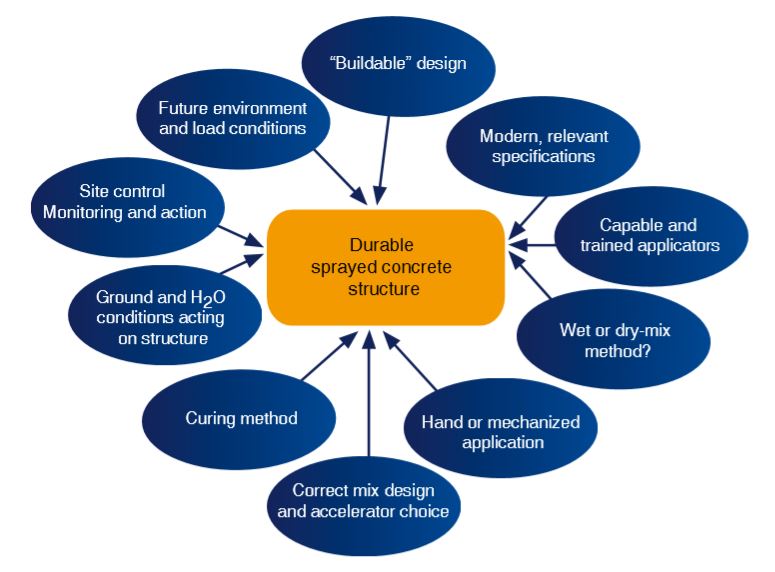Hardened concrete properties in Mining Industry | South Africa
Early-age compressive strength
In modern tunneling, where immediate ground support is often required, the early-age strength of sprayed concrete is decisive and frequently more important than its ultimate strength. The performance of tunneling (advance speed) is strongly influenced by the rate of development of early-age strength, since it determines in soft ground and weak rock when excavation heading can proceed.
Requirements for the early-age strength development of sprayed concrete may vary, depending on the time of its use, between very early strength (from a few minutes to approx. one hour) and early strength (from one hour to one day). After one day the required strength development for sprayed concrete is comparable with that of cast in-situ concrete.
Some factors that influence the early-age strength development of sprayed concrete are:
- Water content of the concrete-mix.
- Cement type and content.
- Type and dosage of accelerators added to the concrete-mix.
- Layer thickness.
- Temperature of concrete and environment.
Improvement of early-age strength development is achieved by the addition of accelerators. However, they may reduce the long-term strength and durability of the sprayed concrete in comparison with a non-accelerated sprayed concrete of the same composition. High dosages/overdosing of accelerators will have a negative effect on the final strengths, permeability, durability and toughness of sprayed concrete (false set, no hardening). The dosage of accelerator in the mix influences these effects proportionally. In addition, the chemical composition of accelerators may affect these important sprayed concrete properties.
The classification of young sprayed concrete may be decided based on the ranges of its significant early-age strength development. For classification purposes, the average range of the typical hardening rate is used, according to the chosen production process and requirements.
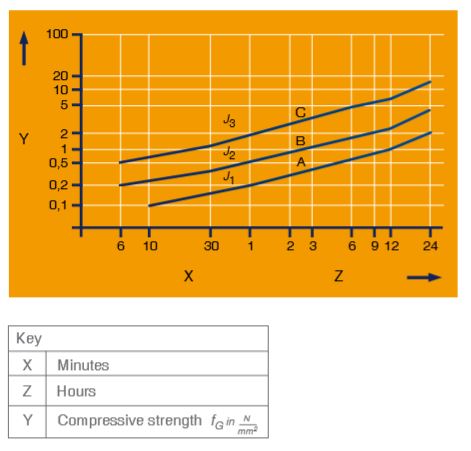
Figure 2-4: Early-age strength classes of young sprayed concrete based on EN 14487-1[32]
The strength development of the young sprayed concrete can be specified according to the early-age strength classes J1, J2 or J3 as described in EN 14487-1 [32], and shown in Figure 2-4.
At least 3 data points (compressive strength vs. time) are required to define the early-strength class. Points falling in the area between lines A and B represent strength class J1, while points located in the area between lines B and C characterize strength class J2. The points falling above line C stand for strength class J3. Other standards and/or specifications may also apply.
Determination of the early-age strength development shall be done according to the expected range of strengths. This topic is described later in section 3.6 of this book.
Final compressive strength
The compressive strength of sprayed concrete is expressed and defined according to EN 206-1. Tests for final strength are carried out at 28 days in accordance with EN 12504-1 on drilled cores, which are taken from the sprayed concrete structure according to EN 12504-1 or from sprayed panels according to EN-14488-1.
Typical final compressive strengths of sprayed concrete at 28 days vary from 30 to 50 MPa. High-strength wet-mix sprayed concrete can be produced, among other things, by the use of high-range water-reducing admixtures/superplasticizers (see section 3.5) to reduce the w/c ratio, and by adding silica fume.
Flexural strength
The post-cracking behavior of fiber-reinforced sprayed concrete can be evaluated by flexural toughness tests. The flexural strength depends mainly on the concrete matrix, even if fiber reinforcement is added to the concrete. It should be estimated from the load-deflection curve and is defined as the stress at the determined first peak load that fiberreinforced concrete withstands when subjected to a flexural test as specified in EN 14488-3 [34].
Toughness
The toughness of fiber-reinforced sprayed concrete can be specified based on the residual strength class which is obtained from a beam test, or on the energy absorption class (from a plate test). According to EN 14487-1 [32], these different ways of specifying the ductility of fiberreinforced sprayed concrete are not directly comparable.
When the concrete characteristics are used in a structural design model the residual strengths can be established. Where the emphasis is placed on energy which has to be absorbed during the deformation of the rock, the energy absorption value measured on a panel can be prescribed.
Residual strength classes
In order to classify residual strengths, a strength level at a certain deformation range can be specified according to the following table and determined in accordance with EN 14488-3 [34]. The specification of residual strength is related to the deformation of the rock mass. Higher deformation of the rock will require higher deflection capabilities of the sprayed concrete lining.
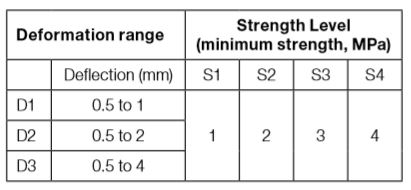
Table 2-4: Definition of residual strength classes according to EN 14488-3 [34]
The different levels of deformation should provide flexibility to designers in the choice of the deformation of sprayed concrete required under service conditions. As an example, class D2S2 means the residual strength of sprayed concrete shall be more than 2 MPa between 0.5 mm and 2 mm deflection. More information and details can be found in [34].
Energy absorption capacity
In cases where the energy absorption capacity of sprayed concrete is specified, it can be determined from a plate specimen tested according to EN-14488-5 [35]. The plate test has been designed to determine the absorbed energy from the load/deformation curve. The determined absorbed energy is a measure of toughness. Biaxial bending, which can particularly occur in rock support, can be modeled more realistically through this test. The central point loading can simulate a rock bolt anchorage. This test is appropriate during pre-construction testing to check all parameters influencing the specified quality requirements of fiber-reinforced sprayed concrete. It allows a comparison of different types of fibers and dosages, as well as a comparison between mesh-reinforcement and fiber-reinforced concretes with the same failure mode. This test is also used as part of the Quality Control Program during construction. In the following table, energy absorption classes are defined according to EN 14487-1 [32].
![Table 2-5: Definitions of energy absorption classes according to [32]](https://assets.construction-chemicals.mbcc-group.com/en-za/definitions%20of%20energy%20absorption%20classes%20according.jpg)
Table 2-5: Definitions of energy absorption classes according to [32]
Modulus of elasticity
High-quality sprayed concrete usually possesses a modulus of elasticity (Young Modulus) ranking from 17 to 40 GPa, similar to conventional concrete. According to EFNARC [29], when the designed capacity or required behavior of the structure is influenced by the modulus (in compression, tension or bending), the in-situ modulus used for structural design shall be verified.
Bond strength to substrate
Sprayed concrete usually presents a good bond with rock, concrete, masonry, steel and other materials, because it is physically driven onto the surface of the substrate. The main factors that influence the development of bond strength are the quality of the substrate, surface preparation prior to application and roughness of substrate, as well as the application procedures (velocity and compaction).
According to the requirements of EFNARC [29], the minimum bond strength of structural sprayed concrete should not be less than 0.5 MPa to rock and 1.0 MPa to concrete. These are average values from three samples at 28 days, and are given for guidance. The requirements must be adapted according to the local conditions of the substrate/ground.
Observation of the failure mechanism, either within concrete (cohesion failure) or between substrate and second layer (adhesion failure), is important to obtain information on the quality of both layers. Adhesion failure is an indication that the substrate was neither cleaned nor prewetted before application or that it dried out due to no or poor curing, or simply due to clay covering a joint or badly cemented sandstone.
Cohesion
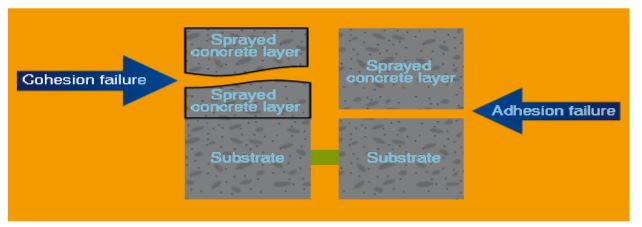
Figure 2-5: Possible failure modes of concrete in a bond strength test
The moisture condition of the substrate during application of the sprayed concrete is important. Bond strength is reduced with an excessively dry substrate (not pre-wetted before application) or wet substrate (due to water ingress) at the time of application. Where multiple layers of sprayed concrete are applied, the surface should be cleaned prior to application of the successive sprayed concrete layer.
The bond of a second layer of sprayed concrete applied on top of a first layer depends on the surface quality of the first layer. Therefore, curing and cleaning dust and/or curing agents from the first concrete layer are essential. However, commercially available curing agents exhibit hydrophobic/water-repellent properties and they may act as a separation layer between the first and the second concrete layer. Their removal is expensive and not always successful. A possible solution is discussed further in Chapter 3.5.5.1.
Shrinkage
Shrinkage is a determining parameter related to potential cracking and bond durability, particularly if sprayed concrete is used for permanent tunnel linings. Where sprayed concrete is used only for temporary ground support, shrinkage is less important because the sprayed concrete lining is mostly under compression, and it does not have to be considered in the lining design.
The potential of shrinkage cracking may be increased by different parameters, including the substrate moisture prior to sprayed concrete application (the substrate may absorb water from the concrete), ventilation or air flow in the tunnel (sprayed concrete layers of min. 50 mm recommended), high cement content and the uncontrolled addition of accelerators.
The drying shrinkage of sprayed concrete is an ongoing process when concrete is subjected to drying conditions. The loss of water held in gel pores causes volume changes. It depends on the mixture proportion and generally ranges between 0.06 and 0.10 % at 3 months (as measured by ASTM C 157).
Sprayed concrete mixes usually consist of a low content of coarse aggregates, a high content of fine aggregates, and cementitious materials, which increase the risk of shrinkage. Therefore, to avoid or limit shrinkage, strict control of the w/c ratio is mandatory.
Density
High-quality sprayed concrete usually possesses a density of between 2230 and 2390 kg/m3, similar to conventional concrete.
Resistance to water penetration
For permanent sprayed concrete linings, water penetration through the lining shall be limited. The resistance to water penetration shall be determined in accordance with EN 12390-8. The maximum value of penetration shall be 50 mm. The test is normally performed at 28 days.
Water penetration can be substantially reduced by the addition of microsilica and by special admixtures.
Permeability
Alternatively, the watertightness of sprayed concrete can be determined by measuring its water permeability. Sprayed concrete is considered watertight when the coefficient of water permeability is less than 10-12 m/s. Permeability to water significantly affects the durability of sprayed concrete. Low water permeability reduces the ingress of deleterious substances in the concrete, thereby inhibiting chemical reactions such as those involving the cement and thus preventing chemical changes.
Permeability of sprayed concrete to water depends on the composition of the mixture (w/c ratio and additives, e.g. microsilica), as well as on optimal compaction. Average permeability values of sprayed concrete may range from 10-12 m/s to 10-10 m/s. Lower permeability values may be reached by the use of alkali-free accelerators. Permeability tests at BASF’s Global Underground Construction with alkali-free accelerated sprayed concrete have shown permeability values in the range 10-11 m/s to 10-16 m/s. Sprayed concrete and concrete show similar coefficients of permeability for given materials and w/c ratio.

Table 2-6: Typical permeability ranges of sprayed concrete (Source: Concrete Society, Technical Report No. 31, 1983)
The diagram below shows the impact of increasing w/c ratio on the permeability of concrete. Low w/c ratios lead to low permeability of the concrete. Additionally, permeability can be substantially reduced by the addition of microsilica and by special admixtures (see Chapter 3.5.5.1).

Figure 2-6: Influence of water/cement ratio on permeability of concrete
Resistance to freezing and thawing
Where freeze-thaw resistance is required due to climatic conditions, this property must be verified. The resistance of sprayed concrete to freezing and thawing depends strongly on the w/c ratio, additives and the quality of the air void system, particularly the content of entrained-air voids and the spacing factor. These parameters can be determined in accordance with ASTM C 457.
According to ACI 506R-05 [30], when critically saturated, wet-mix sprayed concrete requires an entrained air-void system with air content of at least 4 % and a maximum air void spacing factor of lower than 0.30 mm, in order to resist rapid freezing-and-thawing cycles (ASTM C 666).
In the application of wet-mix sprayed concrete, approximately 30 % of entrained air is lost during spraying. According to BASF’s experience, wet-mix sprayed concrete should have at least 4 to 6% air content before spraying, in order to have enough entrained air in the in-situ material. Entrained air, however, may lead to lower compressive strength. Hence, strict control of air content is mandatory. Air content values in the fresh mix should range between 4 % and 6 %. Testing of the air content of fresh concrete may be done according to EN 12350, part 7 [37].
A low w/c ratio, combined with proper air entrainment, is crucial to obtain a desired durability factor greater than 95 %, which corresponds to less than or equal to 5 % weight loss after 300 FT cycles (see Figure 2-7).
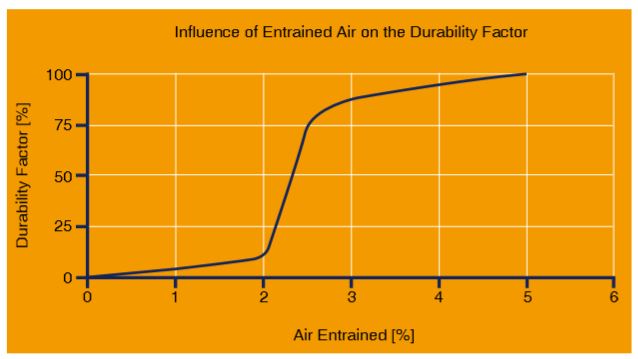

Figure 2-7: Influence of entrained air on the durability factor (Source: US Department of Transportation. Freeze-Thaw Resistance of Concrete with Marginal Air Content, Publication No. FHWA-HRT-06-117, December 2006)
Absorption and volume of permeable voids
Testing the absorption value and the volume of permeable voids is useful to identify poorly compacted sprayed concrete. In addition, a weak or damaged microstructure in the sprayed concrete can be identified through the absorption test (ASTM C 642). It may be conducted on hardened sprayed concrete to provide an overall indication of its quality.
High values of permeable voids or absorption usually indicate poor quality and low durability of the in-situ sprayed concrete. According to ACI 506R-05 [30] acceptable values of permeable void volume vary from 14 to 17 %, while typical boiled absorption values are 6 to 9 %. Results are influenced by the absorptive properties of the aggregate.
Durability
Durability is expressed by the durability factor calculated using the freeze-thaw resistance test. A value greater than 95 % (300 cycles) is required for durable concrete.
In sprayed concrete construction, the correct concrete mix design and cover to reinforcement alone are not sufficient as with traditional cast concrete. The main reason behind this is that the material is spray applied, and consequently the quality is significantly reliant on human skills and spray equipment performance. As can be seen from Figure 2-8, the durability of sprayed concrete linings is established through many possible parameters (see also Chapter 11).
